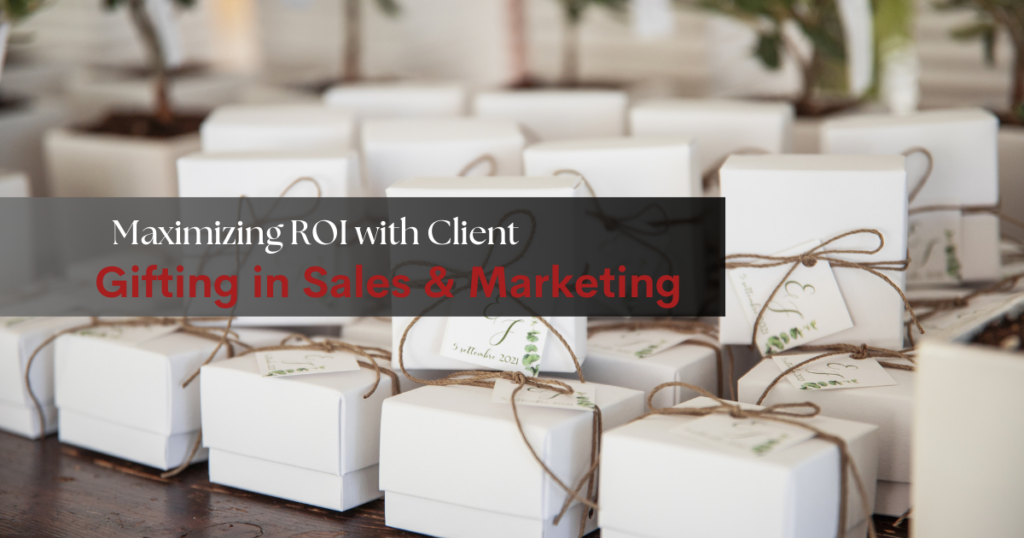
In today’s competitive business landscape, companies must find innovative ways to strengthen relationships with clients while maximizing returns on investment (ROI). One highly effective yet often overlooked strategy is client gifting. Thoughtfully planned corporate gifting enhances client engagement, builds brand trust, and encourages long-term business relationships.
However, to make the most of client gifting, it should be seamlessly integrated into a company’s sales and marketing strategy. A well-executed gifting plan not only nurtures relationships but also drives revenue, improves customer retention, and differentiates your brand from competitors.
In this blog, we explore how to incorporate client gifting into your sales and marketing strategy effectively, ensuring maximum ROI while fostering brand loyalty.
The Role of Client Gifting in Sales & Marketing
1. Building Stronger Client Relationships
Client gifting fosters emotional connections, making customers feel valued beyond mere transactions. Strengthening these relationships leads to increased brand advocacy and repeat business.
2. Enhancing Customer Retention
A well-planned gifting strategy helps maintain long-term relationships. Clients who feel appreciated are more likely to continue doing business with a company, leading to higher retention rates and reduced churn.
3. Creating Brand Awareness & Recall
Strategic gifting keeps your brand top-of-mind. Practical, high-quality gifts with subtle branding ensures clients remember your business whenever they use it.
4. Encouraging Referrals & Word-of-Mouth Marketing
Delighted clients are more likely to refer your business to others. Gifting serves as an indirect marketing tool, encouraging positive word-of-mouth and generating new leads.
5. Boosting Conversion Rates
When used as part of the sales funnel, gifts can influence decision-making. Offering a thoughtful gift at the right stage can help close deals faster and drive conversions.
Strategies for Incorporating Client Gifting into Sales & Marketing
1. Align Gifting with Customer Journey Stages
Gifting should be strategically planned according to where clients are in their journey with your brand. Here’s how:
- Prospecting Stage: A small but thoughtful gift (such as a branded notepad or pen) can create a positive first impression and set the stage for a stronger relationship.
- Onboarding Stage: A welcome gift (e.g., a personalized kit or premium coffee blend) enhances the client experience and builds excitement.
- Engagement Stage: A milestone or appreciation gift (like a luxury item or experience-based gift) strengthens long-term partnerships.
- Loyalty Stage: A VIP or exclusive gift reinforces ongoing commitment and fosters advocacy.
2. Personalize Gifts for Maximum Impact
A generic gift may not create the desired impact. Personalizing gifts based on client preferences, past interactions, or industry relevance makes them more memorable.
- Use a client’s name or company logo on gifts.
- Choose items that align with their interests or business needs.
- Send handwritten notes to add a personal touch.
3. Integrate Gifting with Email & Direct Mail Campaigns
Enhance digital marketing campaigns by combining them with physical gifting.
- Email Follow-Ups: After sending a thoughtful gift, follow up with an email expressing gratitude and reinforcing your brand message.
- Direct Mail Campaigns: Sending personalized gifts with printed thank-you notes helps create a tangible brand experience in an increasingly digital world.
4. Use Gifting to Re-Engage Dormant Clients
For clients who haven’t engaged in a while, a well-timed gift can reignite the relationship.
- Offer an exclusive discount or a thoughtful gift to remind them of your brand.
- Personalize messages to highlight their past interactions and why you value their business.
5. Incorporate Gifting into Sales Incentives
Encourage clients to take action by linking gifts to specific sales triggers:
- Referral Programs: Reward customers who refer new clients with exclusive gifts.
- Gifts as incentives : Offer corporate gifts as incentives for large orders or contract renewals.
- Upselling & Cross-Selling: Encourage additional purchases by bundling gifts with premium services or products.
6. Leverage Seasonal & Event-Based Gifting
Key business milestones, industry events, and festive seasons present great gifting opportunities.
- Holidays & New Year: Send customized corporate gifts during festive seasons to express gratitude.
- Client Anniversaries & Birthdays: Personalized gifts on these occasions strengthen relationships and makes them feel special.’
- Trade Shows & Conferences: Handing out unique gifts at industry events enhances brand recognition.
7. Offer Experiential & Value-Driven Gifts
Rather than just material gifts, experiences create lasting memories.
- VIP Event Invitations: Exclusive invites to company events, product launches, or webinars.
- Customized Training Sessions: Providing industry insights, reports, or training opportunities.
- Charitable Donations in customer’s Name: Aligning gifts with social causes can leave a meaningful impression.
Choosing the Right Corporate Gifts
Selecting the right gifts is crucial for success. Here are some high-impact ideas:
- Tech Gadgets: Wireless chargers, Bluetooth speakers, or smart notebooks.
- Luxury Corporate Gifts: Premium leather goods, gourmet food baskets, or executive gift sets.
- Sustainable Gifts: Eco-friendly tote bags, reusable drink-ware, or plant-based gifts.
- Personalized Merchandise: Custom apparel, engraved pens, or branded journals.
- Experience-Based Gifts: Event tickets, wellness retreats, or premium subscriptions.
Measuring the ROI of Client Gifting
To assess the effectiveness of your corporate gifting strategy, track these key metrics:
1. Customer Retention & Lifetime Value
Compare retention rates before and after implementing gifting. Increased repeat purchases indicate success.
2. Engagement & Response Rates
Monitor customer engagement metrics such as email open rates, feedback, and social media mentions.
3. Referral & New Business Acquisition
Track the number of new leads or referrals generated through gifting initiatives.
4. Sales Conversion Rates
Analyse whether clients who received gifts converted faster or purchased more compared to those who didn’t.
5. Customer Satisfaction & Feedback
Survey clients about their experience with corporate gifts to refine future strategies.
Best Practices for Cost-Effective Client Gifting
- Set a Clear Budget: Determine the cost per client to maintain a sustainable gifting program.
- Choose Quality Over Quantity: Investing in meaningful gifts yields better results than generic, low-cost items.
- Avoid Overly Promotional Gifts: Subtle branding works better than heavily logo-ed merchandise.
- Track & Optimize: Continuously measure the impact and adjust gifting strategies accordingly.
Conclusion
Integrating client gifting into your sales and marketing strategy is a powerful way to enhance relationships, improve retention, and maximize ROI. By strategically selecting meaningful gifts, personalising the experience, and tracking results, businesses can create lasting impressions that drive long-term success.
A well-executed corporate gifting program not only increases engagement but also positions your brand as one that values its customers. Start incorporating gifting into your strategy today and watch your client relationships—and your ROI—flourish!



Hi, this is a comment.
To get started with moderating, editing, and deleting comments, please visit the Comments screen in the dashboard.
Commenter avatars come from Gravatar.